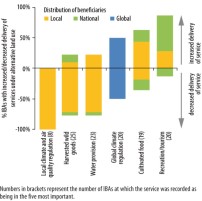
Bird Conservation Nepal has undertaken a project to assess and monitor ecosystem services at all 27 IBAs within the country. The resulting publication ‘Conserving biodiversity and delivering ecosystem services at Important Bird Areas in Nepal’ was launched at the CBD CoP 11 in Hyderabad, India. Bird Conservation Nepal is using the report to advocate for the inclusion of ecosystem values in land use policy, planning and management in Nepal, and has been undertaking actions at targeted IBAs that more effectively conserve biodiversity and reduce poverty.

Ecosystems and the services they deliver underpin our very existence. We depend on ecosystem services for food, water, climate regulation and crop pollination. We also value these services in less obvious ways: contact with nature can contribute to spiritual experience, provide recreational enjoyment and is known to have a positive impact on long-term health and happiness (MEA 2005). Recent studies have also demonstrated the significant economic benefits that ecosystems provide (TEEB 2010) but that are currently not captured in markets. Despite their importance, ecosystem services are consistently undervalued in conventional economic analyses and decision-making. Through understanding, assessing and monitoring ecosystem services, evidence can be gathered to better inform policy formulation, resulting in land-use and management options that deliver more effective conservation, resilient livelihoods and poverty reduction.
Through a project funded by the UK Government’s Darwin Initiative scheme, Bird Conservation Nepal has undertaken a project to assess and monitor ecosystem services at all 27 Important Bird and Biodiversity Areas (IBAs) within the country. In Nepal, the majority of the population lives in rural areas and derives its livelihood directly from ecosystems services. Thus, it is essential that the importance of certain services is recognised.
An expert review was undertaken of the current state of biodiversity and ecosystem services (ES) at IBAs in Nepal, the drivers of change that are impacting upon the biodiversity and ESs and the implication that this direction of change has on beneficiaries—such as the rural poor. The study concluded that the status of habitats and populations of bird species at IBAs has declined in recent years, as a result of increased pressures on land use at these sites. Major pressures include human disturbance, residential and commercial development, overharvesting of resources and poor water management/use. This is changing the overall land use of Nepal’s IBAs with direct impacts on the ecosystem services these areas can provide. Projecting these drivers forward into the near future would see a decline in some key services such as harvested wild goods, local climate regulation and water provision, but a gain in cultivated goods and recreation/tourism. The resulting change in the balance of services would affect people in different ways. The most negatively impacted stakeholders are at the local level, where poorer rural communities are directly dependent on certain services for their livelihoods (BCN and DNPWC 2012).
In addition to this review, field studies at four IBAs have enabled researchers to quantify multiple ecosystem services provided by these IBAs, including carbon, tourism, water provision and harvested wild goods relative to a converted state (e.g. agricultural land) to illustrate the consequences to human livelihoods of losing these sites (Birch et al. submitted). These studies have implemented a new practical ‘toolkit’ for assessing ecosystem services at the site-scale, a pioneering approach that provides guidance on the assessment and valuation of ecosystem services at the site-scale and compares the values to a plausible alternative state (Peh et al. 2013).
The publication ‘Conserving biodiversity and delivering ecosystem services at Important Bird Areas in Nepal’ was launched at the CBD CoP 11 in Hyderabad, India. It is the first example of applying this approach to a network of sites important for biodiversity conservation in one country— Nepal—and analysing the results in relation to decision-making at both the local and national scales. The study provided timely input into the revision of the National Biodiversity Strategy and Action Plan (NBSAP) by the government of Nepal, the commitment by all signatories of the Convention on Biological Diversity (CBD) to set and track targets for improved biodiversity conservation by 2020. The maintenance and restoration of biodiversity and key ecosystem services are highlighted specifically in Target 11 of the 20 Aichi Biodiversity Targets agreed by the CBD. This report therefore helps to provide key baseline information to inform the development of Nepal’s national targets. Bird Conservation Nepal is using the report to advocate for the inclusion of ecosystem values in land use policy, planning and management in Nepal, and has been undertaking actions at targeted IBAs that more effectively conserve biodiversity and reduce poverty.
Related Case Studies in other sections
Links
References
Compiled: 2011 Last updated: 2014 Copyright: 2014
Recommended Citation:
BirdLife International (2014)
Bird Conservation Nepal is assessing ecosystem services at Important Bird Areas.
Downloaded from https://datazone.birdlife.org/sowb/casestudy/bird-conservation-nepal-is-assessing-ecosystem-services-at-important-bird-areas on 22/12/2024